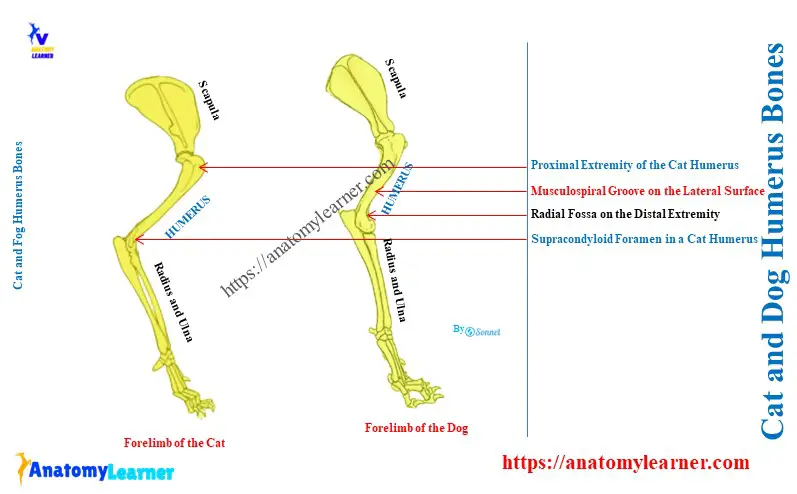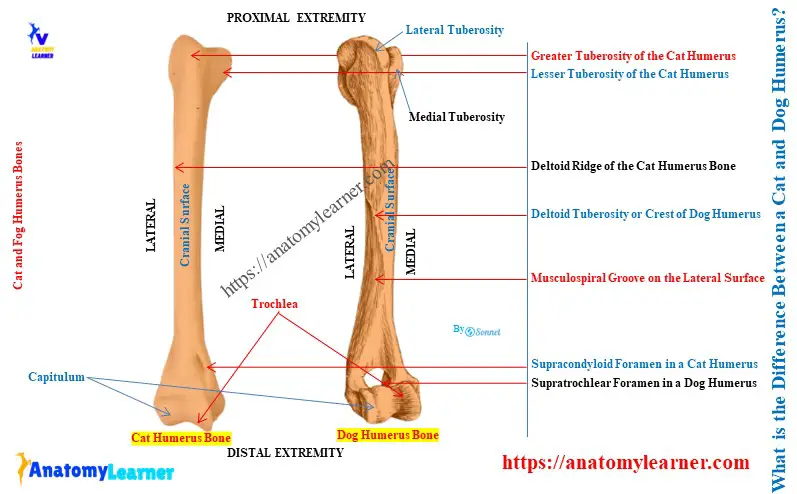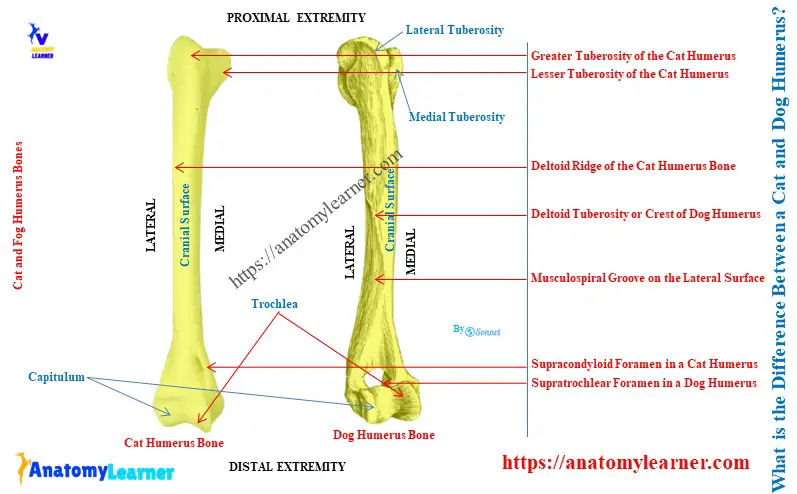The humerus bones of a cat and dog have significant differences in their shaft and extremities. Here, I will provide a concise answer to the question – ‘What is the difference between a cat and a dog humerus?’
Quick answer and explanation: the distal extremity of the cat humerus bone possesses a supracondylar foramen, whereas the dog humerus possesses a supratrochlear foramen. Again, you will find little differences in the shaft, various tuberosities, and lines between the cat’s and the dog’s humerus bones.
I will explain all the differentiating osteological features between a cat and dog humerus with the diagram. So, let’s get started to learn the osteology of these humerus bones and differentiate them from the actual samples.
What is the humerus of a cat and dog?
The humerus is the upper long bone of the forelimb of both a cat and a dog. In both species, it possesses the typical features of a long bone and forms an arm segment of the forelimb.
Here, the diagram shows the humerus bone from the forelimb of a cat and a dog. You will also find the more labeled diagrams on cat and dog humerus bones in the next section of this article.

To differentiate the osteological features of a cat’s and dog’s humerus bone, you might know their ideal structure. A cat’s or a dog’s humerus bone anatomy possesses the following features –
- It has an elongated and curved body or shaft that possesses different osteological features and
- It possesses two extremities – proximal and distal which also contain different important osteological features,
You may know the various osteological features of a cat or dog humerus from the diagram. I have mentioned all the features in the below-mentioned dog humerus bone labeled diagram.
Now, you may compare all these osteological features between a cat and dog humerus bone. But, I would like to compare these two humerus bones with the following osteological features –
- Size and appearance of the shaft of the humerus,
- Features of the deltoid tuberosities,
- Appearance of the greater and lesser tuberosities,
- Features of the musculospiral groove of the humerus bones, and
- Presence or absence of the supratrochlear and supracondylar foramen,
What is the difference between a cat and a dog humerus?
Explanation: Here, the diagram shows the features of a cat’s and a dog’s humerus bones. Grossly, you will find the significant differences in their body and distal extremities.
Here, the body of the dog humerus is a little twisted, whereas the body of the cat humerus is less twisted. But, the proximal part of the body of the cat humerus is a little twisted.
Thus, the musculosprial groove is identifiable in the dog humerus bone. But, if you compare this feature to the ox humerus, then it is less prominent in the dog humerus. In the cat humerus bone, there is no distinct musculospiral groove present.

You will also find an indistinct humeral crest and deltoid tuberosity in a dog humerus bone. However, the deltoid tuberosity is in the form of a ridge in the dog humerus.
Again, the deltoid tuberosity is less distinguishable in the cat humerus bone. This deltoid tuberosity also remains in the form of a ridge in a cat humerus bone.
There are many differentiating features at the proximal and distal extremities between a cat’s and a dog’s humerus bones. But, the presence of supratrochlear and supracondyloid foramen are the most distinguishable features.
Here, Table 1 shows the differences between a cat’s and dog’s humerus bones –
| Osteological features | Dog humerus bone | Cat humerus bone |
| Size of the bone | Comparatively long The body is a little twisted | Longer size The body is not twisted |
| Deltoid tuberosity | It remains in the form of a ridge | Indistinct in the cat humerus |
| Musculospiral groove | Yes, distinct in dog | Indistinct in cat humerus |
| Supratrochlear foramen | Present and communicate between radial and olecranon fossa | Absent |
| Supracondyloid foramen | Absent | Present on the disto-medial aspect of cat humerus |
What are the other osteological differences between cat and dog humerus bones?
You may also differentiate these two humerus bones by the following features:
Tricipital line:
The proximal lateral surface of the dog humerus bone presents a tricipital line. But, you will not find any distinct tricipital line in the cat humerus bone.
Features of the proximal extremity:
There are no distinguishable features on the proximal extremities of cats’ and dogs’ humerus bones. But, the lesser tuberosity of the cat humerus is medial to the head and in the ridge form.
This tuberosity is located below the level of the head of a cat’s humerus bone. In the dog humerus bone, both the lateral and medial tuberosities are located above the level of the humeral head.
The distal extremity of the cat and dog humerus:
Except for the specific foramen, there are other different comparable features between cat and dog humerus. The medial supracondylar ridge on a cat humerus is comparatively sharper than the dog humerus.
Both the capitulum and trochlea are distinct in cat and dog humerus bones. Again, the olecranon and radial fossa are shallow in a cat humerus compared to the dog humerus.
The medial epicondyle is more developed in the cat humerus than in the dog humerus. It continues upward to join with the body and form the supracondyloid foramen.
Conclusion
So, the supracondyloid and supratrochlear foramen are the specific identifying features for a dog and cat humerus, respectively. The curves or musculosprial grooves on the shaft of the humerus are another important identifying feature between a cat’s and a dog’s humerus.

